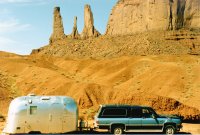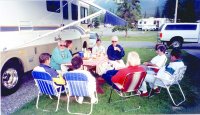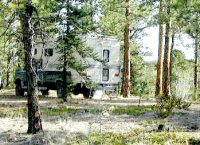RV, Camper, or Trailer Checklist, v14
- RV, Camper, or Trailer Travel-Packing Checklist
- RV, Camper, or Trailer Arrival Setup Checklist
- RV, Camper, or Trailer Departure Breakdown Checklist
 RV, Camper, Trailer Travel-Packing Checklist
RV, Camper, Trailer Travel-Packing Checklist
[ ] Water, Fresh Fill Main,
Auxiliaries, Jugs (1)
[ ] Propane, LP, Cooking Fuel Full
[ ] Batteries Charged
[ ] First Aid Kit
[ ] Tool Kit:
[ ] Screw Drivers (+, -, Torx, Square)
[ ] Sockets & Drivers
[ ] Opened / Closed End Wrench Set(s)
[ ] Adj Crescent Wrenches [a.k.a., "Universal Socket Set"]
[ ] Electrical Repair Kit:
[ ] Wire, Fuses, Crimping Tool
[ ] Taps, Connectors (Butt & Y / Fork)
[ ] Cutting-Stripping Tool
[ ] Tape
[ ] Conduction Test Light / Tool, Multi Meter
[ ] Test Lighting (Brake, Head, Signal, Position, ...)
[ ] Wire Cleaner / Contact Electrical Spray (good stuff)
[ ] Tow Rope / Strap / Cable
[ ] Fire Extinguisher (Always & Only ABC rated)
[ ] Plastic Drain Bucket (for Older Models)
[ ] Large Plastic Boxes (Clear Stackable Best)
[ ] Wheel Blocks, Chalks, Lifts
[ ] Water Hose
[ ] Sewer Hose
[ ] Rubber Gloves for Sanitary Work
[ ] Electric Cord, Extension, Connection
[ ] Electric Outlet-Plug Type Converter
[ ] Level(s)
[ ] Flash Light (Tested, with Spare Bulb & Batteries)
[ ] Short Handle Shovel
[ ] Pick or Pry Bar
[ ] Axe
[ ] Spare Fuel Container
[ ] Funnel (Long neck/flex tube for 90 degree bend)
[ ] Folding Chairs / Stools
[ ] Clean Up:
[ ] Broom
[ ] Dust Pan
[ ] Mop
[ ] Bucket
[ ] Sponges
[ ] Cleaning Solution:
[ ] Floor
[ ] Window (Vinegar Good, Ammonia Bad - ruins some
window tinting finishes)
[ ] Sewage
[ ] Flares
[ ] Water Cans / Jugs
[ ] Long Gas Lighter / Matches
[ ] Hitch with pin and appropriate sized Ball Mount(s)
[ ] Class III Ride Leveling Hardware, Ride/Mount Leveling System :
[ ] Block Chain Pull Down Lever
[ ] Tongue Attachment Blocks with Chain
[ ] Connecting Torsion Bar
[ ] Sleeping Gear:
[ ] Sheets
[ ] Pillows
[ ] Blankets
[ ] Throw Pillows
[ ] Sign(s): Occupied, Family Name, Home, Hobby
[ ] Flag, Holiday Flag(s), Banner
[ ]
[ ]
 RV / Camper / Trailer Setup Checklist:
RV / Camper / Trailer Setup Checklist:
[ ] Level Camper / Trailer / RV
[ ] Block Wheels
[ ] Set Brake
[ ] Set Jack Stands / Hydraulic Leveler
[ ] External Connections:
[ ] Communications, SAT, TV, Phone, Modem
[ ] Electricity
CAUTION: Be sure to
TEST that the AC Electrical Current is Running.
Some site guardians and previous site occupants
turn off the electrical outlet by disconnecting the
Circuit Breaker.
WARNING: We have returned to our RV or Camper,
after leaving it secured in a camp ground,
only to discover that the electricity was not running -
The battery was run dry, food had spoiled,
and the environment wasn't comfortable until
2 AM (all because the electricity wasn't test
validated as operating correctly).
Test Method: We typically operate a hair dryer
as absolute proof that the AC current is in effect.
[ ] Clean Water
[ ] Waste
[ ] Dirty Water
[ ] Appliances (Setting / ON):
[ ] Propane
[ ] Water Pump
[ ] Water Heater
[ ] Space Heater (Set Thermostat)
[ ] Refrigerator
[ ] To Remove Vehicle from Trailer:
[ ] Jack / Tongue In Proper Position
[ ] Disconnect Electr Plug
[ ] Safety Chain
[ ] Unblock Veh / Block Trailer
[ ] Move Vehicle
[ ] Adjust Air Shocks
[ ] Reposition Jack / Tongue
[ ] Lower / Set Stairs / Steps
[ ]
[ ]
 Camper / RV Break Camp Checklist:
Camper / RV Break Camp Checklist:
[ ] Reconnect Vehicle:
[ ] Note Vehicle Fuel Status
[ ] Clear Obstacles between
Trailer and Tow Vehicle
[ ] Check Receiver Lock(ed) or
Pin in with Safety Clip
[ ] Position Jack / Tongue Height
[ ] Position Bumper / Ball / Hitch
[ ] Connect Vehicle
[ ] Validate actual hitch-ball connection, hitch lock down,
then lock safety pin with a keyed trailer lock
[ ] Connect Safety Chains (cross under hitch)
[ ] Connect Electrical Plug
[ ] Unblock Vehicle Wheel / Block Trailer Wheels for re-
connection
[ ] Reposition / Stow Jack / Wheel, Crank Handle Secure
[ ] Adjust Air Shocks
[ ] Appliances (Setting / OFF):
[ ] Note Propane and Electrical Levels / Status
[ ] Propane
[ ] Water Pump
[ ] Water Heater
[ ] Space Heater (Set Thermostat)
[ ] Refrigerator (Off or Switch to 12v DC)
[ ] Lights (Inside & Out)
[ ] External Disconnections:
[ ] Electricity (110v)
[ ] Clean Water
[ ] Waste
[ ] Dirty Water
[ ] Communications, SAT, TV, Phone, Modem
[ ] ALL Antennas Down / Stowed
[ ] Drain Bucket if used
[ ] Check / Verify Status of Electrical
[ ] Service Panel
[ ] Stow:
[ ] Blocks
[ ] Loose Stuff
[ ] Steps
[ ] External Electric Cord
[ ] External Doors, Compartments, Flaps, Vents: Closed, Down, Locked [from Zach W]
[ ] Lift Jack / Stands / Hydraulic Levelers
[ ] Brake Off, Emergency Brake Offs
[ ] Test Lights, Turn Signals, Brakes (2 people test best)
[ ] Walk Around Inspection:
Hint: 25% of the time, a walk around inspection finds something
Hint: Don't forget to walk around at the dump station too!
[ ] Vehicle
[ ] Camper Tie Downs, Doors, Panels
[ ] Frame Mounts on Trailer Tongue
[ ] Roof Line (cable, antenna, ac covers, limbs, overhead storage - all secure)
[ ] Position / Extend Vehicle Mirrors
[ ] Grounds, Camp Site
[ ]
[ ]
(1) CAUTION: When about to camp in Freezing environments, when you can, fill water containers with Hot Water. Sometimes the container needs to be warmed up before filling with Hot Water.WARNING: When overnighting in freezing temperatures, pay careful attention to NOT let water freeze. It takes too much time and energy to thaw frozen water and it takes too many human calories to warm water in the body.
CAUTION: Water Always Freezes 32° F / 0° C, but at higher altitudes with dry humidity, it feels warmer!
WARNING: Water Boils at lower temperatures at higher altitudes, which is potentially both a sanitation and cooking issue (air pressure). At sea level water boils at 212° F or 100° C - As a rule of thumb, for every 500 Feet elevation (or 150 Meters), water boiling temperature drops 1° F (or .5° C).